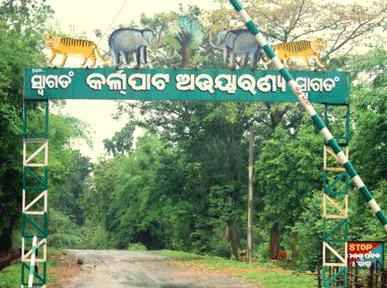Bhawanipatna: February 2021 has turned out to be a dangerous period of the pachyderms.
During last 14 days the Karlapat Wildlife Sanctuary in Kalahandi district is fast emerging as a graveyard for the elephants as at least six jumbos have died.
The latest death was reported on Sunday when a female elephant was found dead near a waterbody.
Of the six elephant deaths, five were female and one a calf. According to 2018 census, Karlapart houseed 17 elephants and now the number came down to 11 in just less than a fortnight.
Divisional Forest Officer (DFO) Kalahandi South Division T Ashok kumar and his team and veterinary doctors are camping in the area undertaking surveillance.
“The death of elephants is due to Hemorrhage Septicemia (HS),” the DFO said.
However, the DFO said that there was no such report about death of other animals in the sanctuary and also the cattle entering to the forest from nearby villages.
Dr.Niranjan Sahu, Coordinator from Center for Wildlife Health, of the Odisha University of Agriculture and Technology( OUAT), Bhubaneswar, after visiting Karlapat sanctuary said: The death of elephants is believed to be by HS. The postmortem report and laboratory report of one dead elephant is hinting at HS (Hemorrhage Septicemia).”
Stating that cattele do get infected to HS if not vaccinated, Dr.Sahu said that this is perhaps the first incident where elephants are also infected to HS.
OUAT Coordinator said vaccination of domesticated cattle in the villages located inside the sanctuary and sanitization is in progress by veterinary staff supported by forest staff. Villagers are asked not to let lose their cattle to the forest.
Chief District Veterinary Officer (CDVO) Dr. Chaitanya Sethi said that as of now there is no reported death of domesticated cattle in the area due to HS. During October there was vaccination but in view of the present scenario further vaccination cover is in progress by veterinary staff now.
Local people and wildlife lovers, however, do not take the incient lightly. Pramod Kumar Singhdeo, a local from Karlapat belonging to the erstwhile Zamindar family of Karlapat and having in-depth knowledge on the flora fauna of the locality, said: “The forest department has dug salt ponds in different places to provide salted drinking water to the wild animals.”
The possibility of poachers poisoning some ponds to kill wild animals cannot be ruled out, he said demanding an investigation into the matter.
“The water from the salt ponds should be sent for laboratory analysis to ascertain the fact. It may also happen that the cattle infected with HS might have transmitted infection in the salt pond which affected the elephants also,” he said.
However, State Wildlife Directorate officials reject the second argument saying that no domestic cattle is found to have the HS infection.
Another local person claimed that though the forest department had earlier installed CCTV Cameras in several spots to monitor movement of wild animals, those were removed for unknown reasons.
They alleged that Karalapat Wildlife sanctuary has already lost many species like wild buffaloes, Mahaseer fish and others. .
Karlapat Wildlife Sanctuary spead over extending 175 square kilometer area is famous for lush green dry deciduous forest, varieties of flora and fauna like, elephant, leopard, Gaur, Sambar, barking deer, Indian wolf, wild dog, wild pig, sloth bear, Malbar giant squirrel and Pangolin.
This apart a varieties of birds like pea fowl, peacock, hornbill, Red jungle fowl, partridges , Spur fawl, Hill Maina, Brahminy kite and reptilian fauna includes Mugger, crocodile, Monitor Lizard, Snakes both poisonous and non poisonous.
The Forest consists of flora like Sal, Bija, Asan, Harida, Amala, Bahada and Bamboo and varieties of Medicinal plants. This Sanctuary starts 12 kms from Bhawanipatna in Bhawanipatna- Thuamul Rampur road.
This Sanctuary was first notified in 1969 by the conservator of Forest and was formally notified under the Wild life protection Act of 1972 in 1992. The undulated topography of the Sanctuary, with Hills, valleys and perennial streams including Sagada River and its tributaries with deep water pools in places gives it unique charm, officials said.
There are several small and big charming waterfalls inside the sanctuary like Phurlijharan, Ghusrigudi, Dumnijhola, Kamalajharan, Koyirupa, Kuang and Raja Rani.


